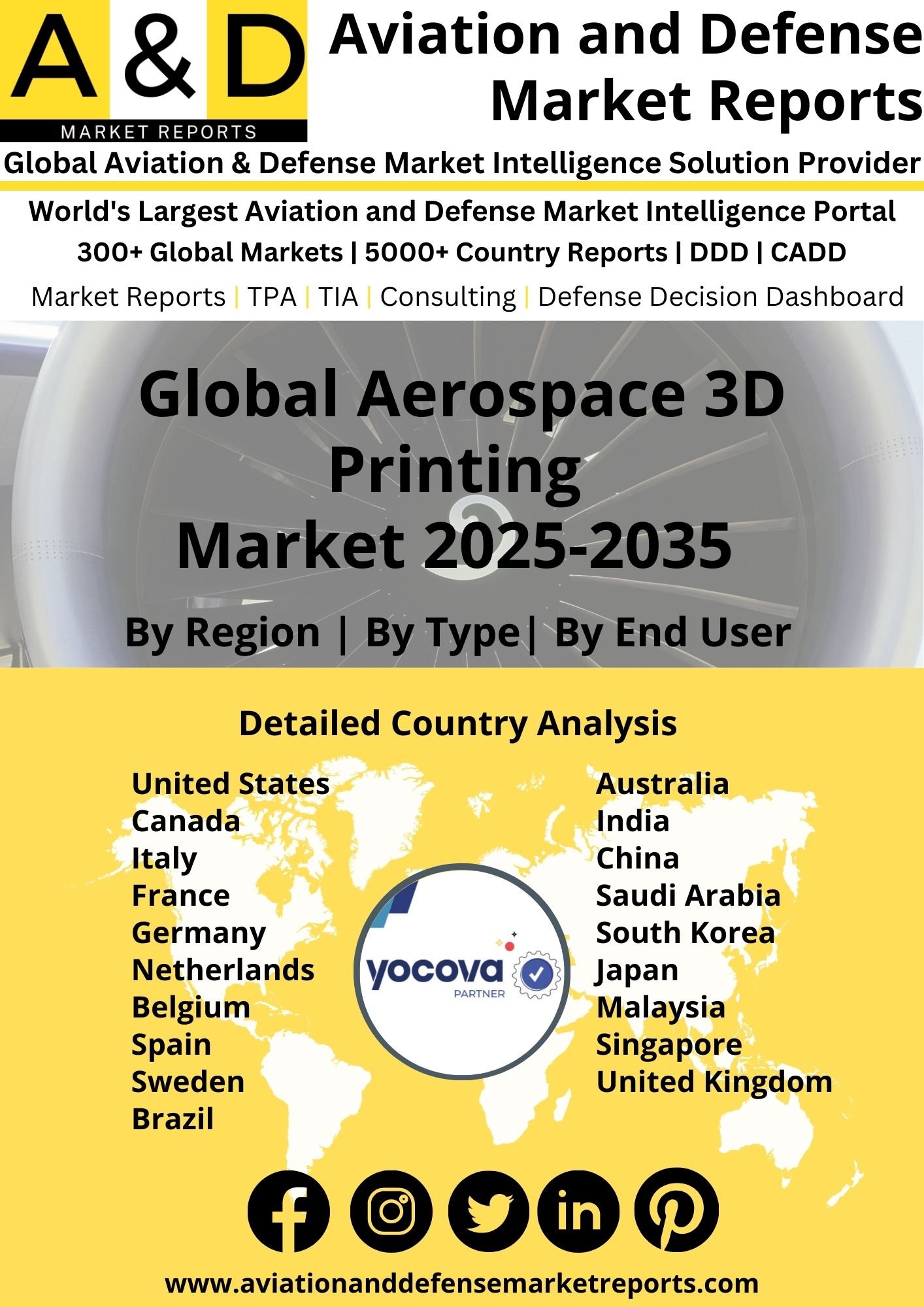Description
Aerospace 3D Printing Market
Frequently Asked Questions of Aerospace 3D Printing
Aerospace 3D printing market sector was noted to be one of the earliest verticals that adopted 3D printing. In the present market, aerospace is still considered the vertical with the highest market adoption for 3D printing. As per definition, the process of building a three-dimensional object from a CAD model or digital 3D model is known as additive manufacturing or 3D printing. It can be carried out via a variety of techniques in which material is brought together, often layer by layer. The deposition, joining, or solidification is all computer-monitored processes that lead to ultimately to the production of the said component/ part.
Major factors driving Aerospace 3D printing Market Growth
Some of the key drivers for this technology is the ability to design and create parts with utmost accuracy. Quicker delivery of parts and the use of non-metallic lightweight materials to do the same are noted to be some of the main reasons that propel the growth associated with this sector. The increased movement towards green technology and the adoption of practices to reduce carbon footprint are hereby noted to be one of the key drivers for this market. The production of lightweight components will hereby optimize fuel usage and the emissions hence generated thus allowing the successful adoption of green initiatives within the aerospace segment.
The latter is particularly important for making strong but lighter parts, solving issues like reducing an aircraft’s fuel consumption by reducing its overall weight, hence reducing operational expenses, and minimizing carbon dioxide emissions — two adversities faced by the Airline industry. Alternatively, relatively low production quantity acquired through technologies like additive manufacturing is noted to be a key market restraint. However, industry specialists have been trying to make technical advances within the said domain.
Trends influencing the Aerospace 3D printing Market Size
Additive manufacturing is a technology of interest for players in the aerospace industry due to external factors in the industry, such as supply chain optimization brought about by decentralized production of parts at the location as per both demand and requirement on-site (as opposed to central production of parts and shipping them around). The decentralized production methodology employed by Aerospace 3D printing market size allows added transport and portability of products across the global markets. With the possibility for a globally dispersed production network, organizations may maintain appropriate inventory levels to maximize productivity and create new value chains across industry verticals while also realizing significant cost savings.
However, true build portability can be ensured only by having a set of guidelines that ensure a standard of manufacturing. Some of these parameters that ensure a common standard of manufacturing across global markets for a said product include a secure method for transferring digital information, common equipment, appropriate quality certifications, accurate equipment calibration, consistent input materials, etc.
Additionally, it is noted that the use of Aerospace 3D printing market report in aerospace reduces the number of components to be manufactured while making use of raw materials like composites. This is predominantly because of the added malleability of the material which hereby reduces the assembly time for a given structure. The number of failure points for a given structure is also reduced through the incorporation of Aerospace 3D printing market trends as a manufacturing technology. This is predominantly due to the reduction of manual labor which in turn lowers the possibility of human errors in the construction of a given structure. The aerospace and military industries’ polymeric non-structural parts are no longer the focus of industry participants’ efforts; instead, secondary structures and key systems applications are taking their place.
Aerospace 3D Printing Market Forecast & Dynamics
In the applications segment for the 3D printing market forecast, it is noted that prototyping acquires the largest share within the market. The other domains that acquire a major share within this market are as follows, i.e. Repair and Maintenance, Research and Development, Production Parts, Jigs, Fixtures, Tooling, etc.
Market Analysis for Recent Developments
As per Airbus CTO Grazia Vittadini, an aircraft was noted to be roughly 55 percent lighter owing to 3D printing. The average-sized Boeing 737-800, which is operated by several well-known commercial airlines, weighs 90,000 pounds (without fuel or passengers), but a reduction of 55% would reduce its weight to just over 40,000 pounds. This will reduce the quantity of fuel used by the aircraft because its weight directly correlates with its fuel consumption throughout the airframe’s useful life. In other words, 3D printing improves the aircraft industry’s sustainability.
The AI-driven software AMAIZE from 1000 Kelvin, a startup based in Berlin/Los Angeles that is leading the way in AI solutions for metal and polymer 3D printing technology, will be fully available for purchase at Formnext 2023. The business is also announcing its first partnerships with customers, such as a California-based rocket launch provider, and manufacturers of commercial 3D printers, such as EOS. According to Omar Fergani, Ph.D., co-founder and CEO of 1000 Kelvin, “the manufacturing and production sector accounts for one-fifth of global carbon emissions and 54% of the world’s energy usage.” “Until 3D printing operates consistently, it will not be able to address these issues uniquely. AMAIZE contributes to a more sustainable future by increasing productivity, decreasing waste from 3D printing, and simplifying the technology.” With the aid of physics-informed AI technology, AMAIZE makes it possible to generate the best print recipes for first-time, accurate 3D printing. When a print file is uploaded to the AMAIZE cloud, the part is analyzed, and by optimizing the scan strategy and process parameters, thermo-mechanical issues are automatically corrected. This removes the need for numerous physical iterations and pricey finite element simulation software, which wastes resources like time and money. A number of machine OEMs have already directly incorporated 1000 Kelvin’s cloud-native solution AMAIZE, enabling next-generation AI software and compute infrastructure for additive manufacturing. AMAIZE has been successfully implemented by companies in the energy, aerospace, and contract manufacturing sectors following the conclusion of its early adoption program.
Key Companies






